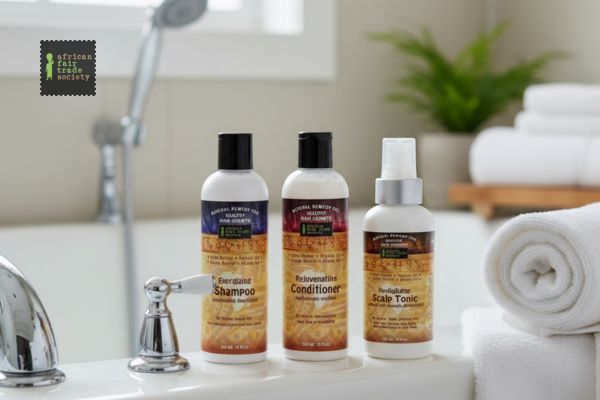Can Using Shea Butter Actually Cause Your Hair to Shed?

Can Shea Butter Cause Hair Loss?
Shea butter is prized in hair care and skin care products for its rich moisturizing properties. Raw, unrefined shea butter contains vitamins A and E, essential fatty acids, and other nutrients that are perfectly suited to soothing dry hair, scalp, and skin. When included in hair products, shea butter can provide deep conditioning, add shine, soften hair, and protect against breakage over time.
However, some people may experience adverse effects from using shea butter for hair. Firstly, you have to identify your shea butter. In rare cases, using shea butter improperly or excessively can potentially lead to increased hair shedding for certain individuals. Here’s a closer look at how shea butter interacts with hair, and how to use it properly to avoid unintended hair loss.
The Moisturizing Benefits of Shea Butter for Hair
The vitamins, fatty acids, and other nutrients in raw shea butter can provide fantastic moisturizing potential when applied to hair. The fatty acids in shea butter are similar in molecular structure to the lipids present in hair cell membranes, allowing it to really penetrate the hair shaft with deep conditioning effects.
For people with dry, brittle, or damaged hair, shea butter can replenish lost moisture, promote elasticity, and protect strands against environmental damage that leads to breakage over time. When hair is properly moisturized, it is stronger and less prone to static, frizz, tangling, and excessive shedding during brushing or washing.
Shea butter also contains anti-inflammatory compounds that may soothe dry, itchy scalp conditions which can improve hair growth environments. And shea is rich in vitamins A and E, providing compounds that can nourish hair follicles when massaged into the scalp. So when used properly as part of natural hair care routines, raw shea butter offers fantastic benefits for softening hair, adding shine, preventing breakage, and even stimulating growth over time.
Potential Reasons Why Shea Butter Could Lead to Hair Loss
While the moisturizing fatty acids in shea butter can provide fantastic nourishment for soft, healthy hair growth, using shea butter improperly does pose some risks in certain cases. Some potential reasons why using shea butter excessively or incorrectly might contribute to hair shedding include:
Using Pure Shea Butter That's Not Blended Properly:
Raw shea butter is very dense in texture and also has a weird smell. Spreading chunky, pure shea butter directly onto hair can be challenging, and failing to evenly coat strands leads to inconsistent moisturizing. The gritty chunks could also physically pull on delicate strands and lead to some breakage.
Applying Too Much Shea Butter to the Scalp:
While massaging small amounts of shea into the scalp provides nutrition for the hair follicles, applying excessive butter directly to the scalp can lead to buildup and clogged pores just like in skin care. This scalp irritation can impede proper follicle function and contribute to shedding.
Having an Allergy or Sensitivity:
For those with plant-based sensitivities, shea butter allergies can definitely lead to scalp issues, irritation, redness, and increased hair shedding in reaction to the components. An allergy is most likely to blame if increased hair loss coincides with scalp itching or irritation after using shea products.
Tips to Use Shea Butter Properly for Hair
To enjoy shea butter's many protective, moisturizing hair benefits without unintended increase of hair shedding or loss, the following tips are recommended:
Do a Patch Test for Allergies:
Rub a small dab of pure shea butter onto skin like the inside of your wrist and wait 24-48 hours to check for redness or itching, which would indicate allergy. Use 100% raw shea butter from a reputable source that isn't contaminated for most accurate test.
Mix Pure Shea Butter With Other Oils:
For easier, more even application, blend raw shea butter with melting/mixing oils like coconut, avocado, olive, or jojoba oils according to your hair’s needs before applying.
Only Use a Small Amount Focused on Hair:
About a dime-sized amount of shea butter product distributed across all hair should suffice. Too much can lead to buildup on scalp and strands. Focus application on midshaft down, avoiding direct contact to the scalp and evenly coating all hair.
Switch Formulas If Increased Shedding:
Discontinue use if extra shedding, loss, or irritation occurs and try a different brand or formula blend instead to identify if an allergy or sensitivity is to blame.
The takeaway is that high-quality, raw shea butter can be an amazing hair treatment for softening dry hair and preventing breakage over time. But blending shea butter for hair properly with other compatible oils and avoiding excessive use can help prevent potential irritation or allergy issues that may contribute to hair shedding for certain individuals.
When used carefully as part of natural hair care and styling routines, shea butter is a fantastic addition for keeping strands moisturized and minimizing grooming-related breakage. Combining shea butter with gentle handling techniques and protective styles focused on retention will provide the best environment for soft, healthy hair growth over time.
Get High-Quality Shea Butter from African Fair Trade Society
At African Fair Trade Society, we ethically source 100% raw, unrefined shea butter straight from women’s co-ops in West Africa to provide superior moisturizing beauty products while supporting fair wages. Our authentic Grade A shea butter is gently handcrafted and naturally nourishing for skin and hair.
Give your strands the shea TLC they deserve while promoting social impact with fair trade shea butter artisan products. African Fair Trade Society prioritizes ethical cultural preservation and women’s empowerment with every sulfate-free order.





